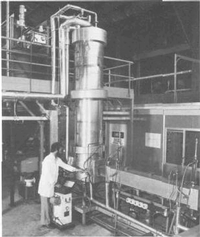


Chapter 6
I Construction During The Settlement Years
II The Use Of Timber As A Structural Material
III Structural Steel
IV Concrete Technology
V Housing
VI Industrialised Pre-cast Concrete Housing
VII Ports And Harbours
VIII Roads
IX Heavy Foundations
X Bridges
XI Sewerage
XII Water Engineering
XIII Railways
XIV Major Buildings
XV Airports
XVI Thermal Power Stations
i Steam Power Stations Using Brown Coal
ii Fabric Filters for Coal Fired Power Stations
iii Thermal Electricity Generation in Queensland
iv Conversion of Kwinana Power Station from Oil to Coal Firing
v Remote Area Power Supply Alternatives in Western Australia
XVII Materials Handling
XVIII Oil Industry
XIX The Snowy Mountains Scheme
XX The Sydney Opera House
XXI The Sydney Harbour Bridge
XXII Hamersley Iron
XXIII North West Shelf
Sources and References
Index
Search
Help
Contact us

The fouling problems of the Morwell and Hazelwood boilers highlighted the need to more fully investigate the properties and characteristics of future La Trobe Valley coals, so as to allow a more reliable prediction of their performance in a boiler, and where the coal is likely to cause fouling, to enable a more suitable design of the boiler to be adopted. This has been accomplished by the use of experimental furnaces which are designed to simulate conditions in a full size boiler. Sample coal from bore holes in future coal fields are burnt in the furnaces and all factors relating to the formation of deposits and the condition of the deposits are carefully studied and evaluated. The effect of the scale factor is minimised by burning known coals in the furnaces and using these as a reference base. The following briefly describes the furnace currently in use.
35 Kg/h Furnace
This experimental furnace is used when a range of tests is required on a limited coal sample, to provide a rapid appraisal of the fouling behaviour of the coal under different combustion and deposition conditions. Normal test periods run for 4 1/2 hours. The facility consists of a 610 mm diameter, down-fired, refractory lined cylindrical furnace, 2,440 mm high, and using pulverised coal at a feed rate of 35 kg/h. The gases from the furnace exhaust into a horizontal, rectangular working section, 205 mm x 230 mm, where they flow around cooled tube banks simulating superheter sections. Gas cooling, electrostatic dust separation and exhaust gas scrubbing equipment are installed downstream of the test tube banks. The furnace can be operated at gas temperature from 805°C to 1300°C at the tube bank. Tube bank metal temperature can be varied from 350°C to 850°C.
1000 Hour Furnace
The furnace is used for testing the ash fouling propensity of coals under long term deposition conditions and with regular steam soot-blowing. Long term continuous operation for 1000 hours also provides the opportunity for investigating high temperature gas side corrosion of boiler tubes. The facility consists of a 460 mm diameter, down-fired refractory lined cylindrical furnace, 2,800 mm high, using pulverised coal at a feed rate of 12 kg/hr. Gases exhaust from the furnace at 1000°C into a horizontal, rectangular working section in which two banks of air-cooled tubes are installed. The tubes are short lengths of actual superheater tubes. Once past the tube banks the gases are cooled and then cleaned by an electrostatic precipitator before being exhausted up a chimney. A view of this furnace is shown in Fig. 63.

Coal Handling and Storage
The Victorian brown coal is a difficult material to handle and store, with strong tendencies to build-up in chutes and liable to block outlets from bunkers. Boiler bunkers using conical or pyramid outlets proved to be particularly troublesome, requiring frequent use of air lancing and manual prodding to maintain constant flow to the boilers. To overcome this a new design of bunker was evolved and, in addition, a conveyor belt was used at the bunker outlet rather than the normal scraper chain or apron plate type feeder conveyor, which had high maintenance costs. The principle underlying the bunker design was to provide for nearly continuous outlet flow along its entire length (thus minimising dead coal pockets) and yet still be segregated to flow into six or more feeder conveyors. This was achieved by angling the conveyors under the bunker and having the coal feed sideways on to their length.
Organisations in Australian Science at Work - thermal power stations, named; thermal power stations, named
People in Bright Sparcs - Sutherland, K. N.
 |
Australian Academy of Technological Sciences and Engineering |  |
© 1988 Print Edition pages 399 - 401, Online Edition 2000
Published by Australian Science and Technology Heritage Centre, using the Web Academic Resource Publisher
http://www.austehc.unimelb.edu.au/tia/396.html